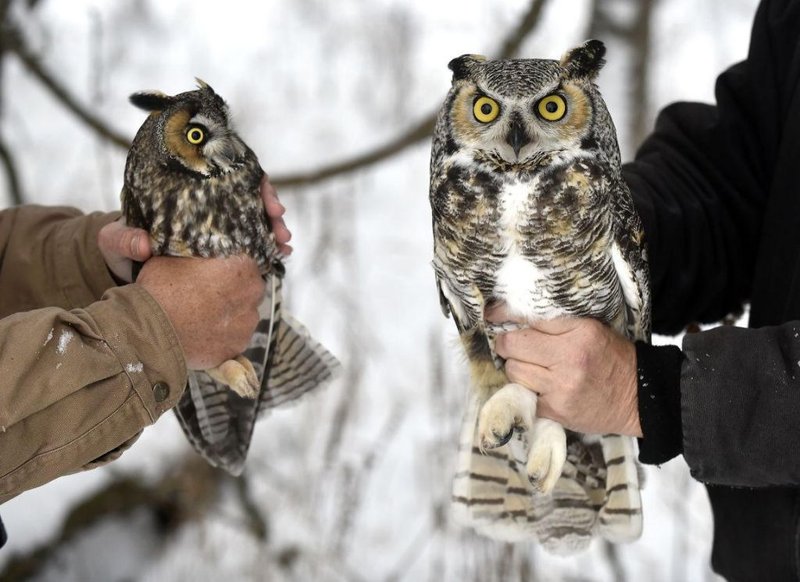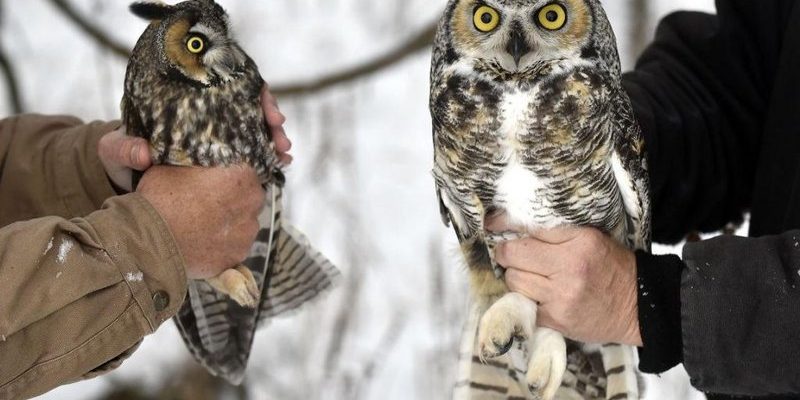
When you think of owls, you might picture them as wise and mysterious, perched silently in the trees. The Great Horned Owl is a perfect representation of this stereotype, boasting striking features. However, it’s not the only bird in the owl family. In fact, there are several species that share its habitat and may even be mistaken for it. By looking closely at their unique traits—like size, coloration, and vocalizations—we can appreciate the rich diversity within the world of owls. Let’s break down the key differences to help you identify these magnificent birds.
Spotting the Great Horned Owl
The Great Horned Owl is a true heavyweight in the owl world. Standing at about 18 to 25 inches tall, it’s one of the largest owls in North America. You can easily recognize it by its striking yellow eyes and tufted “ears” that give it a regal appearance. The feathers are mottled brown and gray, perfect for blending into the trees.
When shining a flashlight into the trees at night, the Great Horned Owl’s eyes can appear bright and piercing. They have a characteristic “hoot” that can echo for miles, making it one of the most recognizable sounds in the wild. Their call is often described as a series of deep, booming hoots, which serves both to establish territory and to communicate between mates.
Here’s a fun fact: Great Horned Owls are remarkably adaptable. They can thrive in various habitats, from forests to urban areas. If you ever spot one, just remember you’ll likely see it perched on a high branch, silently observing its surroundings.
Comparing Size and Appearance
Now, you might be wondering how the Great Horned Owl compares to its close relatives, like the Eastern Screech Owl and the Barred Owl. While the Great Horned Owl is a giant, the Eastern Screech Owl is much smaller, typically around 6 to 10 inches tall. It may appear less intimidating, but its beautiful plumage—ranging from gray to red—makes it a stunning sight.
Barred Owls, on the other hand, are another common species that can be spotted in similar habitats. They are medium-sized, measuring about 16 to 25 inches tall but lack the distinctive ear tufts of the Great Horned Owl. Instead, Barred Owls have rounder faces and are characterized by their striped appearance, which can help them blend into their surroundings.
When thinking about spotting these owls, size and distinctive markings are your best clues. If you see a large owl with prominent ear tufts, it’s likely the Great Horned Owl. Meanwhile, if you notice a smaller owl with a more rounded face, it could be an Eastern Screech Owl.
Habitat Preferences
Habitat is another significant area of difference among these owl species. The Great Horned Owl is quite versatile and can adapt to various environments. They can be found in forests, parks, or even around rural and urban areas. This flexibility is one reason why they are so widespread across North America.
In contrast, the Barred Owl prefers mature forests, often near water. You’ll usually find them in dense woodlands where they can hunt for small mammals, birds, and even fish. This preference for a specific habitat can sometimes limit their range compared to the adaptable Great Horned Owl.
The Eastern Screech Owl, meanwhile, favors open areas with plenty of tree cover. They thrive in urban settings and can often be found in backyards, which makes them one of the more accessible owl species for birdwatchers.
Understanding these habitat preferences can guide your owl-spotting adventures. Keep an eye on the type of environment you’re in—if it’s a city park or a dense forest, you’ll likely encounter different species.
Vocalizations and Communication
Vocalizations play a huge role in differentiating owl species. The Great Horned Owl has a distinct, low-pitched hoot that sounds almost like it’s calling you from the depths of the forest. It’s a sound that resonates with the evening air, marking its territory and attracting mates.
Comparing this to the Eastern Screech Owl, their calls are notably different. They produce short, descending trills or “whinny” sounds that often make them sound more like a horse than an owl! This unique vocalization is a clue that helps bird enthusiasts identify them.
Barred Owls, on the other hand, are known for their “who cooks for you, who cooks for you all” call, which is rhythmic and somewhat melodic. It’s quite different from the deep hoots of the Great Horned Owl and can make for an interesting evening in the woods as you listen for their distinctive sounds.
You might find that listening closely can give you a lot of information about which owls are nearby. It’s all part of the adventure of birdwatching!
Diet and Hunting Strategies
When it comes to diet, the Great Horned Owl is a versatile predator. Known to eat a variety of prey, including rabbits, rodents, and even larger birds like geese, its size and strength give it an advantage. These owls are skilled hunters, using their acute hearing and keen eyesight to detect movement even in low light.
On the other side, the Eastern Screech Owl typically preys on smaller organisms like insects, small mammals, and birds. Their smaller size limits their hunting strategy, but these owls are masterful at camouflage, allowing them to ambush prey with surprising effectiveness.
Barred Owls are also skilled hunters but prefer small mammals and birds, much like the Eastern Screech Owl. However, their larger size means they can tackle slightly bigger prey than their smaller counterparts.
What’s fascinating is how different hunting strategies can lead to varied diets among similar bird species. The Great Horned Owl’s broad diet complements its size, while the smaller owls have adapted their hunting techniques to suit their needs.
Breeding and Nesting Behavior
The breeding habits of the Great Horned Owl are quite remarkable. These owls often start nesting in late winter or early spring, depending on the region. They typically use abandoned nests from other large birds, like hawks or crows. This reuse of nests, rather than building their own, showcases their adaptability.
In contrast, the Eastern Screech Owl often prefers to nest in tree cavities or even birdhouses. They lay around two to five eggs, which both parents help incubate. This cooperative approach to parenting is common among owls.
Barred Owls, like the Great Horned Owl, also utilize abandoned nests or tree cavities. They tend to lay about two to four eggs, and both parents are involved in raising the young, taking turns hunting for food.
Understanding the breeding and nesting behaviors of these owls can deepen your appreciation for their life cycles. Watching these owls raise their young can be one of the most fulfilling experiences for any birdwatcher.
As we’ve explored the differences between the Great Horned Owl and similar bird species, it’s fascinating to see how diverse owls can be. From size and appearance to vocalizations and nesting behaviors, each species plays a unique role in their ecosystem.
Next time you’re out in nature, take a moment to listen and look for these incredible birds. Whether you encounter the Great Horned Owl with its powerful presence, the smaller Eastern Screech Owl with its intriguing calls, or the elegant Barred Owl, each one contributes to the rich tapestry of wildlife around us. By recognizing these differences, you’ll not only enhance your birdwatching experience but also develop a deeper appreciation for these nocturnal wonders. Happy birding!

